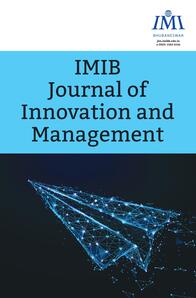
1 SIES Institute of Comprehensive Education, Mumbai, Maharashtra, India
2 Carpediem EdPsych Consultancy LLP, Ajmera Treon, Bhakti Park, Wadala(E), Mumbai, Maharashtra, India
Creative Commons Non Commercial CC BY-NC: This article is distributed under the terms of the Creative Commons Attribution-NonCommercial 4.0 License (http://www.creativecommons.org/licenses/by-nc/4.0/) which permits non-Commercial use, reproduction and distribution of the work without further permission provided the original work is attributed.
We are living in an ever-changing world. The changes in science, technology and economics constantly impact areas closely related to human life, such as education and health. Organisations must rely on innovation to remain relevant and effective in a constantly evolving society. Educational institutions, namely schools, colleges or even training institutions, contribute to product innovation when they produce new and significantly different products and services such as new syllabi, new resources or new educational experiences like e-learning. They carry out process innovation when they bring about significant changes in how they provide their service, for instance, changes in the way their teachers work together, communicate with parents or offer services in collaboration with other institutions. With the onset of the medical catastrophe of COVID-19 and the pandemic thereafter, the education sector plunged itself into adapting to the use of technology to keep its service functional, albeit with significant challenges faced in its effective implementation. In this article, the focus is on studying technology implementation in an early childhood care teacher-training institute to establish service innovation in education in the post-pandemic era. Multiple perspectives were derived from all the stakeholders, such as student-teachers, teacher educators and heads of schools (as future employers) regarding teacher preparedness and student-teacher readiness. The inputs helped us to develop the conceptual model for future teaching-learning. The conceptual model A.D.O.P.T. (Act with growth mindset, Deliver Quality, Open to Adaptation, Prioritize with Precision, Team Engagement) highlights how the stakeholders move from makeshift ‘jugaad’ innovation to sustainable development of the educational system through grassroots innovation.
Service, innovation, hybrid learning, teacher training institute, early childhood care
Introduction
The modern society is a knowledge society (Audretsch, 2014; Etzkowitz, 2013; Lorentzen, 2009; Narasimharao, 2009; O'Shea et al., 2005). It is proven that different regions, states and countries have varied economic and social development. Universities have begun to play a more significant role in the growth of the economy and society in general (Etzkowitz, 2003a, 2003b), making them an essential component of innovation systems (Etzkowitz,1998). All educational institutions must constantly innovate to contribute to the knowledge systems.
There are some characteristics of innovation that are identified over time, namely (a) tangible aspects in an organisation or across multiple organisations, such as product, process or procedure; (b) it is new to the organisation to which it is introduced and not new in the introduction; (c) it is not a routine change and (d) there should be measurable outputs that are universally identified.
Furthermore, for innovation to be sustainable, educational organisations must ensure the following: (a) a triangular relationship between social policy (governments and social partners), practice (teachers, learners and other larger audiences) and research groups with a common agenda for these actors; (b) there needs to be a cross-institutional transfer of innovation across organisations and (c) there is an integration of changing learning environments, content, methods, media, validation and assessment, teachers and trainers in a structural manner.
It is noteworthy that the innovation for education and training is still at the very nascent stages (Shapiro et al., 2007). As per Rogers, who was considered a pioneer in sociological innovation studies, there are three types of innovations: (a) individual-based innovation, (b) organisation-based innovation and (c) innovation by few individuals with authority in the organisation. In an education system, innovation belongs to higher authority and the organisation is driven by or percolates through to other stakeholders in the system. It was also believed that the adoption of innovation would be adopted with an increased rate (Rogers, 2003a, 2003b).
Researchers have often highlighted the criticality and importance of a 360-degree change in the education systems. The literature also observed that the changes in the university systems extensively are made from the perspective of innovation (Clark, 1998) and entrepreneurship (Clark, 1998; Etzkowitz, 2003a, 2003b, 2013; Urbano & Guerrero, 2013; Yusof & Jain, 2010). There needs to be a shift from traditional teaching and learning practices to more innovative ideas. Interaction between the industries, government and universities is necessary for socio-economic development, forming part of the triple helix model (Etzkowitz, 1998; Goldstein, 2010; Sardana & Krishna, 2006; Yokakul, & Zawdie, 2009). Still, there remained resistance to any significant change until COVID-19, and the related pandemic ensured that all stakeholders were forced to innovate and change to stay relevant (Pokhrel & Chhetri, 2021; Selvaraj et al., 2021).
The COVID-19 and the pandemic it triggered had global influence. Several governments, notably the Indian government, imposed lockdowns to stop the spread of the virus (Sintema, 2020). They touched various industries, including education. Different countries closed schools and educational sectors (Kuensel, 2020). Multiple strategies were used to keep the teaching-learning process going.
Despite the disruption and health difficulties caused by the pandemic, many believe that it has presented a chance to implement digital teaching and learning (Dhawan, 2020). The desire to keep educational institutions open for as long as possible encouraged stakeholders to innovate.
This article has studied a teacher-training institution as a real-life case. We have analysed the perspectives of different system stakeholders and the innovative practices that came into being during this period. This research article is divided into the following sections. The second section highlights the theoretical background of innovation, innovation in education and the research motivation. The third section highlights the methodology; the fourth section is the case illustration section that gives details of the teacher-training institution and the case considered; the fifth section covers the analysis and discussion based on the case; the sixth section details about the proposed conceptual model A.D.O.P.T.; finally, the seventh section concludes the article and provides the future scope of the article.
Theoretical Background
To better understand the proposed conceptual model, it is essential to determine the background behind the model. The underlying concept is based on innovation in a given system. Particularly in this research, we have focused on innovation in the education system. In this section, we highlight: What is the concept of innovation? What are the varying types of innovation? What is the role of innovation in economic growth and development and in education?
This research aims to assess whether the system under consideration is carrying out innovation (Harvard Business Review, 2013; Ridley, 2020; Rogers, 1983, 2003a). If yes, then whether it is implementing innovation to a level of satisfaction as per standards. To assess whether a system has the capability of innovation, we need to highlight the basic characteristics of innovation. Further, keeping in mind the theoretical background, we also highlight the research gap for the study and state the research questions.
Many have spent decades trying to grasp the concept of innovation. In many circumstances, numerous constant patterns have been observed, whether low or high tech, huge or little, disruptive or helpful or both. One thing is sure: innovation has never been instantaneous but incremental (Ridley, 2020). Also, innovation is distinct from invention. Ensure that the invention reaches the market to benefit the customers. Innovation is sometimes accidental and fortuitous. Innovation results from numerous technologies together—for example, Google self-driving cars, Facebook and Instagram. Often, innovation involves trial and error.
To innovate, a team must work together. Norman Borlaug’s tenacity and ambition spawned the famed green revolution in agriculture. Many people around the world triggered the main notion. The innovation hype cycle varies. People exaggerate the short-term impact of new technology while underestimating its long-term influence. Innovations necessitated more dispersed control stifles creativity. It also saves resources and tries to produce more. It is a multi-dimensional concept. In the following sections, we will explore different elements of innovation and some recent study definitions. We strive to connect the sorts of innovation to the educational situation (Fullan, 2007; Krishna & Krishna, 2005). This linkage of innovation and education will eventually lead to system evaluation based on innovation implementation (Rogers, 2003a, 2003b).
Role of Innovation in Economic Growth and Development of Society
How societies are now described is based on the knowledge that they develop. A knowledge-intensive society is one in which the majority of group members help in the production and reproduction of knowledge (OECD, 2014). For the past couple of decades, various jobs in production, processing and transferring knowledge and information have emerged. These jobs were initially only in the high-technology and information and communications service sectors and subsequently across all other sectors.
Establishing economic development can only be possible if knowledge creation takes place. Over time, it is well established that creating new knowledge or using existing knowledge in innovative ways leads to overall economic growth and development. Further, the progress of science and technology at an accelerated pace leads to knowledge creation. The more the creation of knowledge, the more innovation is needed, and it, in turn, leads to the development of society in different dimensions (Narasimharao, 2009). It is also concluded that the link between knowledge and economic productivity and growth is based on two pillars: (a) innovation, which leads to the creation of new knowledge and its application to new or better products, service processes and many organisations, or the application of existing knowledge and technology to new contexts, and (b) training and development, which leads to a skilled and better workforce that aids in the application of new knowledge and information, or the application of existing knowledge and technology to new contexts.
These two main pillars can further be related to education and training to deliver the human capital necessary for innovation capacity development in society. There is a significant consensus that the following aspects are essential: (a) education and learning: there is a need to keep reforming the education and training systems so that they can respond to the needs of the knowledge society, high level of skills and continuous learning throughout life1 and (b) investment in research and development, promotion of enterprise development and collaboration between organisations.
Role of Innovation in Education
The notion of innovation is sometimes unclear and not always agreed upon (Adams et al., 2006; Sidorkin & Warford, 2017). The literature has extensively discussed innovation. In this study, the context of each innovation type is considered. ‘Jugaad’ is a popular kind of innovation. According to Prabhu and Jain (2015), it is the art of generating effective solutions in a system with limited resources. Brem and Wolfram (2014) compared innovation kinds. They said jugaad innovation is simple; Gandhian invention is simple to medium; catalytic innovation, frugal engineering and indigenous innovations are medium, and reverse innovation is high. The study also explored the sustainability of different types of innovation, with ‘jugaad’, frugal engineering and reverse innovations being the least sustainable and Gandhian, catalytic, grassroots and indigenous innovations being the most sustainable innovations.
Smirnov (2017) gave a pragmatic definition of innovation. This definition is termed grassroots innovation and considers any educational initiative taken by a teacher, a student or an entrepreneur to work on it individually or as a small group. According to this definition, irrespective of which definition of innovation holds for the educational initiatives taken, it remains imperative to assess the viability and potential impact of the initiative. Carter et al. (1996) state that the project in educational innovation essentially must survive the early stage for sustainability in the future. It can further be seen that if the project survives the obstacles, then growth can be the basis of its success.
Innovation is often used in businesses and has also been adapted to the education context from the Oslo Manual (OECD, 2005) by OECD (OECD, 2014). As per the report,
Educational organizations introduce (1) new products or services, (2) new processes for delivering services, (3) new ways of organising their activities, (4) new marketing techniques. These new practices improve the provision of education in one way or another, and therefore innovation in education should be regarded as ‘improvements’.
There is always a debate about which activities would be considered improvements. Some of the activities may only benefit one group of people, maybe the low-income families but not the high-income families. Thus, it is unclear whether such activities should be considered an innovation. Amidst this ambiguity, many activities are considered to be innovations. This includes the use of learning management systems being tagged as an innovation (Soffer et al., 2010), or a student internship abroad (Spiering and Erickson, 2006) or change in the style of lecture (OECD, 2014).
Research Gap and Motivation
The study will assess the level of innovation in an educational system in India. The education system has attempted to adopt changes for the past several years. However, due to the pandemic, the innovation got dispersed in the system at a catastrophic level. To the best of our understanding, many have discussed the role of the education sector in times of a pandemic. Not many researchers have discussed it from the point of educational institutions’ role in developing knowledge society. Some of the significant gaps addressed in the study:
Research Questions
After getting an idea of each type of innovation, we assess the following:
Methodology
As discussed in the previous sections, Rogers diffusion of innovation theory (Rogers, 1983) is also widely used in the educational setting (Shea et al., 2005; Spiering & Erickson, 2006; Soffer et al., 2010; Warford, 2005). In this theory, the innovation is shared with the members of the social systems via many different channels (Rogers,1983, 2003a, 2003). The success of diffusion of the innovation depends on the characteristics, the social environment and the change agents around it. We developed the design to determine what changes are made at various levels to ensure the success of innovation. Figure 1 describes the study’s research design and helps to understand whether innovation characteristics hold for the teacher-training institution in our research.
Figure 1. Framework of the Study.
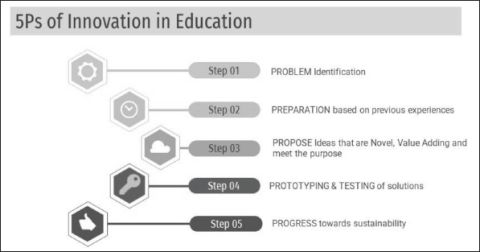
Source: Adapted from Serdyukov (2017).
Further, it is essential to understand what aspect of innovation would lead to the sustainable development of the education system in any situation. We have reviewed the case institution keeping this as a background. The objective is to assess the extent of innovation implemented. On the other hand, if innovation has not been implemented or has not been implemented up to the standard level, we will propose suitable changes to make the system sustainable. Figure 1 highlights the framework of the study.
Case Study Design
As per Yin (2014), case study research involves studying a real-life contemporary context. The case may be an individual, a small group, an organisation or a partnership. Some authors, such as Stake (2005), suggest that case study research is not a methodology but a way to choose what must be studied. Yet others present this as a methodology or a comprehensive research strategy (Denzin & Lincoln, 2005; Merriam & Tisdell, 2015; Yin, 2014). Usually, a case study is considered a qualitative approach. The investigator explores the contemporary situation over time in a detailed manner and collects data from multiple sources such as interviews, documents and reports. The unit of analysis may be one single unit or numerous units of the study.
In this article, we have considered the view of Yin (2014) and taken the case study as a methodology. This approach helps us study the teacher-training institution and the innovation brought in the system. For the analysis, we considered multiple stakeholders of the institution as our units of analysis. We have tried to understand different stakeholders’ perspectives through various interviews and brainstorming sessions. The stakeholders here include the teacher educators, the student-teachers and heads of educational institutions (future employers). The primary objective is to study innovation in the teacher-training institution. More specifically, how this innovation has been implemented and the features needing improvement to ensure sustainable innovations. We also study the influence of the pandemic on innovation in the system and how the institution has shifted from ‘jugaad innovation’ to finally ‘grassroots innovation’ for developing a long-term sustainable institution.
Figure 2. Details of Case Study.
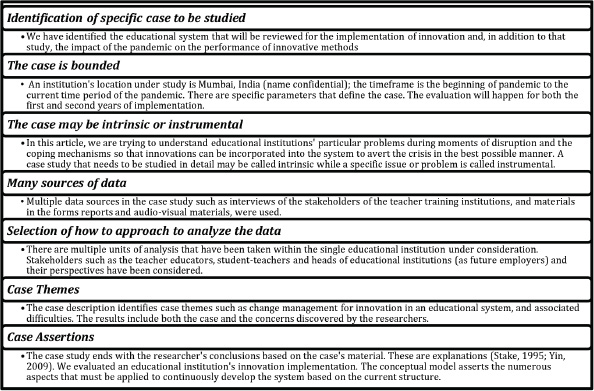
The case study method has specific characteristics (Denzin & Lincoln, 2005; Merriam & Tisdell, 2015; Yin, 2014). Identified in Figure 2 are the details of the case study that shows the linkage between these characteristics and the research in context.
Case Illustration
In this article, the specific case study evaluates how well innovation has developed and diffused into the case of a teacher-training institution (name not mentioned due to confidentiality) in a disruptive environment due to the pandemic. The COVID-19 pandemic affected every country, state and city worldwide, impacting all sectors, including education. Overnight when people from various schools and colleges were asked not to come to work, every person had a question: What would be the next step?
In this research, we have attempted to consider the perspective of three different stakeholders: (a) teacher educators, (b) student-teachers and (c) heads of educational institutions (future employers), to assess the system as a whole and how each group managed the crisis brought about by the pandemic. The research aims to understand whether the incorporated methods helped the system function as smoothly as possible in a crisis. Further, we try to assess the current level of standard in the teacher-training institution from every stakeholder’s perspective and the process improvements.
The institution being assessed is a teacher-training institution that predominantly trains student-teachers for early childhood centres and schools. Taking this specific institution had multiple purposes. While the pandemic affected educational institutions and university departments, they all implemented changes to educate their present pupils better. But a teacher-training institution’s impact lasts for years since it prepares future teachers who will be accountable for ensuring quality education for many generations to come. The institution under study offers numerous programmes in early childhood care and education (ECCEd) through two campuses in Mumbai and Navi Mumbai, India.
We included teacher educators, student-teachers and educational leaders in the case study. We worked with these stakeholders to understand their teaching-learning practices prior to the pandemic and what changes they needed to make. We studied their interdependence to see how they met various demands and if any modifications were required to keep the system sustainable. Figure 3 depicts the stakeholder system and its interdependence. Teacher educators prepared student-teachers for future employment. Teachers conducting online instruction for their pre-primary kids were the focus of the pandemic’s first and second phases. The third phase would involve recruiting future-ready teachers.
Timeline of the Case
The stakeholders of the system made plans across the three phases: (a) a contingency plan at the start of the pandemic under sudden disruptive conditions, (b) a medium-term plan to ensure teaching-learning practices were not disrupted under the lockdown scenario and (c) a long-term plan for developing a sustainable educational system for future. Figure 4 describes these three phases. The sections that follow discuss the three phases in detail.
Analysis and Discussion
As Netolicky (2020) notes, in a crisis, leaders must act swiftly and with foresight and careful consideration of options, consequences and side effects of actions taken. Given the teacher-training institution crisis at the very beginning of the COVID-19 pandemic, it was evident that each of the stakeholders felt that there would be a need for change (Harvard Business School Press, 2007). Many uncertainties existed, and it was still unclear how the day-to-day activities would be performed. Over a short period, everyone came to terms with the fact that there would be a long lockdown period. It was realised that one could not continue in the makeshift arrangement like the initial period. There was a need for a plan. Planning to go online for a few days was very different from going online for a minimum of one semester, given the pandemic conditions. Undeniably in a few months, the COVID-19 virus became a ‘supernova’ (Azorín, 2020), creating ‘undeniable chaos’ (Hargreaves & Fullan, 2020) and shaking the very fabric of education. Thus, it required a lot of thinking and preparation. Unfortunately, however, improvement efforts in education break down more often than not because these efforts overlook the complex interdependencies across the system, which gets in the way of effective implementation (Arnett & Moesta, 2021). With the given situation where no one was left with an option, everyone had to ensure that they performed well to make changes in the system.
Figure 3. Early Childhood Care and Education System and Its Stakeholder Relationship.
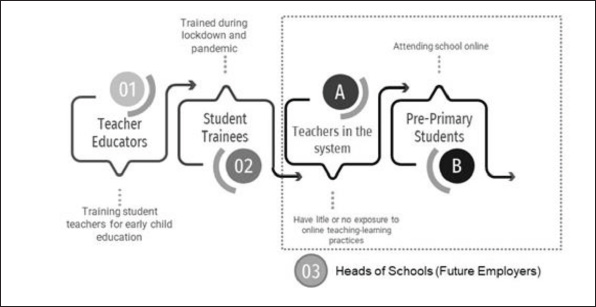 ]
]
Figure 4. Case-Study Timelines.
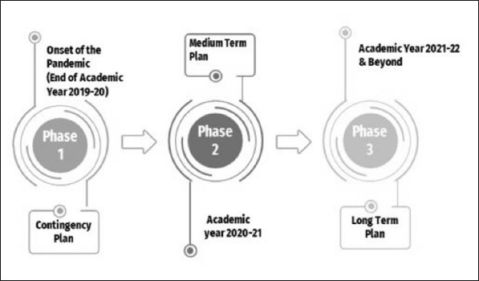
For teaching-learning as a process that exists in an educational organisation, the aim is to improve the process continuously. The need for continuous improvement is always to address the challenges that exist in the system. In the analysis of the situation, it is noteworthy that the stakeholders in the system need to identify the challenges that exist in the system currently. Once the system’s current status is understood and challenges are identified, it is always easy to structure steps to be taken for the future, though continuously improving the system at each stage. For a continuous improvement of the system, we usually address three essential questions: (a) What is the problem that one is trying to address? (b) What changes in the system one wants to bring about and the reasons for implementing these changes? (c) What indicator shows that the change has brought improvement?
Most definitely, the pandemic gave impetus to this change. The changes that need to be made in any system take a collective effort, differ in different contexts and always require adaptation, data collection and continued new learning (Bessant & Caffyn, 1997; Bhuiyan & Baghel, 2005; Langley et al., 2009). Many players involved in a system need to focus on specific problems in practice and always find ways to improve the processes continuously through iterative cycles. The changes required in the system may be a set of new approaches, tools or different strategies to address the problem (Bryk et al., 2015). With the changes, the stakeholders in the system reskill and upskill themselves to change and then test the new practices, further refine changes based on requirement and then implement the recent changes on a larger scale over time (Langley et al., 2009). It can be highlighted that the continuous improvement can be seen to have the following principles: (a) changes required take time and involve collective effort (Bryk et al., 2015; Katz et al., 2009), (b) the context needs to be specified and (c) there have to be multiple series of small changes, combined with a lot of evidence that can lead to large-scale change (Derrick-Mills et al., 2014; Hawley, 2006; Park et al., 2013; Snow et al., 2017).
Keeping in mind the idea of continuous improvement, we collected the data from stakeholders—teacher educators, student-teachers and heads of educational institutions of the system—to highlight how each stakeholder played a role in improvement at each stage.
Coping with the Initial Disruption Student-Teachers of the Teacher-Training Institution
Student-Teachers at the End Academic Year 2019–2020 and Those Joining the New Academic Year in 2020
Multiple questions were posed to the student-teachers of the training institution at various levels. Those questions were related to the course completion and the impact of the online training structure on learning, their recruitment or starting the new academic year.
Teacher Educators and Dean of Institute
This group consisted of six teacher educators and the dean of the teacher-training institution. The dilemma they faced was how they would continue the teaching-learning process. In the initial phase, the focus was to have a makeshift arrangement for classes, to continue as smoothly as possible. Teachers did not know how to connect; some connected through their phones using video applications such as Zoom, Webex, Microsoft Teams and the like. Others sent recorded lectures or notes through email, WhatsApp or other formats. While these solutions initially seemed appropriate, the real question remained: Were these solutions sustainable in the long run?
Not surprisingly, each day presented new obstacles. After finishing the subject content, the educators had to complete the evaluation. The instructors’ main issue was how all student-teachers would be assessed, especially if it was done online. Several questions arose. Every day, teachers-educators were plagued with queries ranging from the simple to the sophisticated. How to connect with student-teachers all across the world? Concerns about internet connectivity during the assessment? How would they examine ethical malpractices? These are only a few of the questions that the teacher, educators and dean discussed. This phase was semi-structured; each teacher educator chose their evaluation methods, such as phone interviews or online exams. The question remained: Were their actions sufficient, or did they need to do more? The problem for teachers satisfied the system’s and student-teachers’ diverse needs.
Heads of the Educational Institutions–Future Employers
For any teacher-training institute like in the given case, one of the most important stakeholders and an essential part of the chain are the early learning centres and the pre-primary and primary schools that employ the future student-teachers. At the start of the pandemic, like all other organisations and set-ups, the heads of these institutions also faced the question of how the teaching-learning process would continue. The challenge was far enhanced because their students were the toddlers and the young children for whom starting online classes was unheard of. The institutions were not sure of what formats they would follow to create the learning environment for their young students, and also, if they hired a recruit, how would they train the recruit in the practices of their schools.
Evaluation of the Initial Teaching-Learning Practices
After handling online teaching in the COVID-19 pandemic situation for a year, we assessed the system. All the stakeholders were able to reflect on the happenings last year, what is currently happening and what will happen. Continuous improvement is a well-known quality management tool, and we use the framework of specific quality management tools to analyse the system better. We utilise the Plan, Do Study and Act (PDSA) cycle as proposed by Deming (Katowa-Mukwato et al., 2021; Moen & Norman, 2006; Taylor et al., 2014) as the background for a framework for continuous improvement. We have analysed the situation of one year of the pandemic and attempted to examine ways to improve the system for the future. We want to understand what innovative measures we can take so that the educational system works as smoothly as possible. The sections that follow detail the plan of action based on inputs from the stakeholders about the teaching-learning practices.
Student-Teacher Evaluation
As discussed in the methodology section, we conducted interviews with the student-teachers to understand their perspective on how the design for online teaching and learning of the teacher-training institution worked for them in the disruptive phase of the pandemic.
We interviewed a mixed batch of 15 student-teachers of ECCEd courses at the teacher-training institution. The student-teachers of the ECCEd course were interviewed one-on-one through online mode. The interviews were about 45 minutes to 1 hour long. In the unstructured interview, we understood the working of the educational system.
Figure 5 depicts the insights highlighted by the student-teachers. The student-teachers had overall positive feedback about how the system functioned in the given crisis. However, some aspects were missed out, like observing the lessons of senior teachers or being able to take sessions during internships. From the respondents’ reactions, it could be established that they would prefer an offline mode. Those who did say that they wished to be online were only comfortable with a hybrid model and not a completely online one in the future. Going entirely online for many subjects is not possible in the current state. Also, going online is not possible as social interaction is necessary for student-teachers, and thus, it is essential to maintain a mix of environments for learning.
Figure 5. Insights from the Student-Teacher Evaluation.
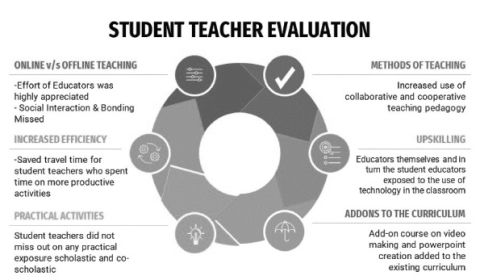
Teacher Educator Evaluation
The teacher-training institute played a crucial role in analysing the modalities of all teaching-learning processes during the pandemic. The self-evaluation helped address what innovations were brought about from ‘jugaad’ innovation (under the sudden disruption and change) to grassroots innovation for sustainable development if it has to last and support a system for a considerable period of time in the future (Smirnov, 2017).
A brainstorming session was conducted with all the teacher educators participating. We addressed the innovations brought about by them at each stage, keeping the PDSA cycle in mind. The brainstorming session lasted for over 2 hours. The underlying structure of PDSA was given to the teacher educators, keeping in mind that continuous improvement had to be made for the system to function effectively. At each stage, with extensive discussion, we assessed how the system worked. Depending on how the system worked, we understood how the system needed to be changed to achieve better. On the basis of the details of PDSA,2 we were subsequently able to develop a conceptual framework for future continuous improvement.
Plan Phase: Changing industrial demands over the last decade meant substantial changes in education. The COVID-19 pandemic supplied essential momentum to the existing undercurrent of transformation. We highlight the teacher-training institution’s phase-by-phase plans to improve the system continuously.
In the current framework of planning for the teaching-learning process in the educational system, contingency plans had to be created in Phase I to keep the system running. Phase II focused on areas not covered in Phase I, after the stakeholders had experienced Phase I. The goal was to improve future planning for sustainable systems. With Phases I and II completed, the teacher-training institution could better plan for the future. Phase III planning included more precise methods for the new batch and future sustainable systems. Figure 6 highlights the planning phases.
Do Phase: In this phase, the idea is to implement what is planned for, that is, whether in this current case, it may be a contingency plan or a long-term plan. The plan is implemented and then studied to see how it gets integrated into the current educational system.
Phases I and II: Learning MS Teams in collaboration with all faculty; learning how to make videos for pre-recorded lectures; e-internship; virtual field visits; admissions till December 2020; multiple choice questions for evaluation; proctoring as best possible by teacher educators for exams; Sharepoint for data sharing; admission from India and abroad; enterprise resource planning implementation for standardisation to highlight some; and there were many smaller implementations in the entire overhaul of the system.
Phase III: Due to the tragic nature of COVID-19, many teacher educators and student-teachers view the needs of students from a new perspective. Facilitators would need to handle and aid student-teachers deal with stress levels and the overwhelming requirement for assignments and online teaching and learning assessment. In addition to personal empathy, facilitators must use new instructional methodologies. Many new applications and debates were released during the year, allowing teacher educators and student-teachers to understand the teaching-learning process better.
Figure 6. The Planning Phases.
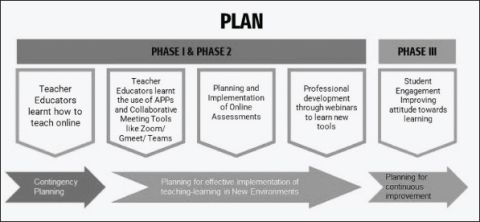
Study Phase: When we implemented a brainstorming session for the teacher educators, they brainstormed extensively and analysed the system. They were able to highlight the causes of the significant innovation for continuous improvement. The fishbone diagram in Figure 7 helps segregate the reasons in broadly six dimensions: man, method, machine, material, measure and milieu. Further, the sub-branches of the leading causes highlight the main actors and system components that led to the innovation in the system. It must be understood that highlighting the reasons does not mean that all the factors may be accurately functioning. If there are some flaws in the design, then after analysis, the flaw would be rectified. Appropriate actions were either taken between Phase I or Phase II of the pandemic or will be taken in the system while making the institution sustainable in Phase III and beyond.
Given that there are always ongoing improvements that are needed, the system is evolving day by day to make the teaching-learning process as seamless as possible with the help of the stakeholders of the system. Highlighting a few flaws that were observed in this phase: (a) for instance, in the sudden movement of the teaching-learning process online, reference books were not always available; (b) staff, whether administrative or teaching faculty, were not initially being able to adapt to the new sudden changes in the system and maybe they have still not adapted to the system complexity; (c) assessment and proctoring were not perfect but near perfect given the constraints and (iv) not everyone is privileged to have all machines and equipment with them. It is necessary to address these issues and need to be acted upon.
Act Phase: After analysis, system modifications are required to sustain innovation. This PDSA cycle was only done once in this study because we examined the system once after Phases I and II ended. As a result of performing PDSA, teacher educators were not complacent in letting problems discovered in Phases I and II continue into Phase III. The separation of the ‘plan’ and ‘do’ stages emphasises this point. Since Phase III is still underway, any observations made will help stakeholders further examine how to continuously enhance the system. The PDSA cycle can be repeated to reassess and evaluate the system. The highlights of the discussions in the above sections following the PDSA cycle model have been summarised in Figure 8.
Figure 7. Fishbone diagram for Defining Main Causes for Innovation in the Teacher-Training Institution.
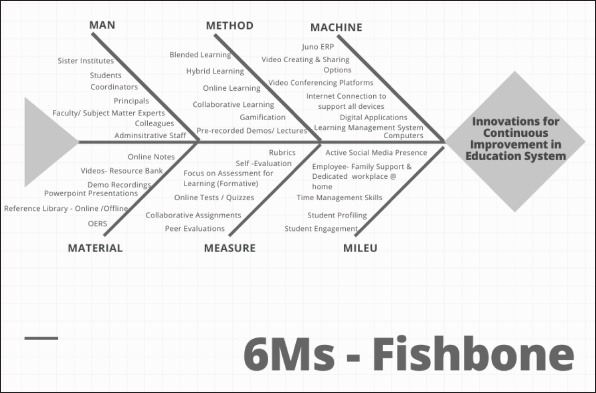
Source: Based on Inputs from Brainstorming Session.
Figure 8. PDSA Cycle Based on Teacher-Training Institution.
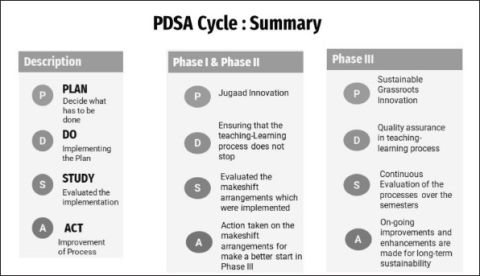
Source: Based on Inputs from Brainstorming Session.
Heads of the Educational Institutions—Future Employers
To keep the school running smoothly, they would have to adapt. They had to ensure that with the support of their professors and administrative staff, they could handle the obstacles that they faced. Their answers revealed how they played a vital role in handling the system’s mandatory adjustments. They became change managers and had to handle change in every situation. It was inconceivable to see schools closing for the entire lockdown. Adaptive adjustments were required to improve the system’s long-term sustainability. While they expected educators recruited in Phase II to be resilient and receptive to change, they expected much more in Phase III. To create equitable environments for teaching and learning, post-pandemic teachers would need to learn how to use technology, not only for education but also for evaluation. They would need to be critical thinkers and problem solvers.
Conceptual Model for the Future
Based on the system evaluation in the previous part, we created a model for future sustainable innovation. Reacting to crises with many stakeholders in mind (Harvard Business School Press, 2009). Change management is a major responsibility of leadership. The disruptive developments must be viewed as an opportunity for the organisation to succeed. To change organisations and individuals, especially when change is resisted, we must modify our thinking (Harvard Business School Press, 2007). The COVID-19 pandemic is the most recent crisis. During this time period, many industries were affected, whether manufacturing or service. The educational sector was also damaged in multiple ways. The sector has been completely restructured to meet the demands of the new normal.
In a crisis, leaders can use four primary behaviours to help them handle the issue (Harvard Business School Press, 2020). Previously, organisations focused on expansion, but today they focus on sustainability. In an educational institution, growth was measured in terms of admissions. The pandemic has posed the question of whether growth is enough for organisations. During the pandemic, priorities shifted. They had to prioritise survival and function before considering development and expansion. Leaders must be able to make quick decisions, adapt to changes and continually assessing the system to understand the impact on the system and its stakeholders. Considering the role of leadership in crisis situations, we believe comparable considerations should be made in educational institutions. The institution's response to a crisis is heavily reliant on the leadership’s actions. The system would flourish and be sustainable with a top-down strategy and dedicated personnel in the company.
On the other hand, a strong educational institution should withstand future uncertainty. To construct a conceptual model that would lead institutions in the future in building sustainable solutions, we used lengthy debates and deliberations throughout the article. Interviews and brainstorming sessions helped us understand how various stakeholders handled the issue.
Challenges that Exist in the System
There are always challenges, and there are always two ways to look at the challenge. Either one can keep counting the negative aspects of the challenge in front of us or consider the opportunity that might have been created out of the challenge. Here the challenge was the pandemic and the related crisis situation. Many institutions were not able to change at the speed at which was required and perished. Under the case consideration with the vision and mission of the Dean and the team effort, the educational institution moved from initial 'jugaad' innovation to modifying the system towards sustainable innovation through grassroots innovation (Smirnov, 2017). Figure 9 challenges of the system are highlighted.
In the highlights that follow, we have stated how the teacher-training institution stakeholders have collectively stated the changes in the teaching-learning process in the future.
Figure 9. Challenges in the System
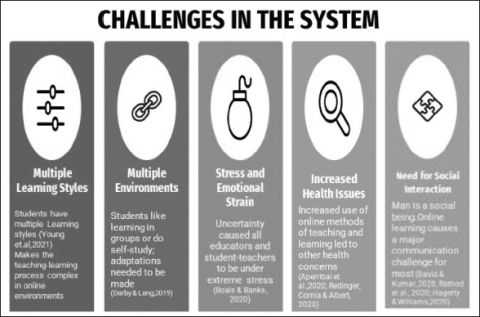
Source: Inputs from Brainstorming Session
Figure 10. Proposed A.D.O.P.T Model for the Sustainable Education System
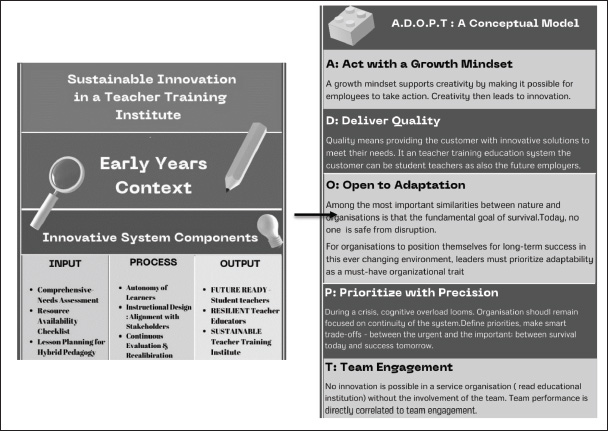
Source: Based on the evaluation of the case of a teacher-training institution.
Means to Overcome the Challenges
i. Student profiling: Student profiling detects not just learning styles and student interests but also readiness for learning (Nowakowska et al., 2020; Xu & Pimtong, 2021).
ii. Effective use of technology – hybrid style of teaching: To deliver, teachers needed to upskill themselves in order to use technology effectively quickly. During the pandemic and thorough talks, it became clear that some parts of the online mode of teaching and learning are beneficial to incorporate the long-term, whereas others are fine in the offline form. So, a hybrid approach to teaching and learning is a wonderful idea. For the educational system to survive, administrative modalities and standard operating procedures must be established (Nancy et al., 2020).
iii. Instructional design: Creating resources and learning experiences that help students apply information and skills. The educational design aims to make instructions efficient, engage learners, and address learning objectives in cognitive, emotional, and psychomotor domains (Boettcher & Conrad, 2021).
iv. Classroom discussion based on application-based learing: The times are changing, and students’ readiness for the workplace is questioned. The pandemic has made this topic more urgent. When considering the education system as a whole, it becomes clear that some old approaches will be obsolete in the future. Less rote learning and more application-based learning are required. Rather than restricting student-teachers use of technology, teacher educators must support application-based learning fueled by technology (Boettcher & Conrad, 2021; Darby & Lang, 2019).
v. Project-based learning: Due to the pandemic, we now know that pupils must be able to complete specific tasks independently with minimal coaching. This is vital since on-the-job teachers cannot answer questions. They must be able to assess and act swiftly and accurately. During the epidemic, there were no physical meetings with teachers, and while there were online meetings, there were always periods where students had to judge for themselves and act. Rather than being viewed negatively, this component must be viewed positively to ensure that student-teachers are market-ready (Yakur et al., 2020).
vi. Student engagement: Among the many differences between online and offline teaching, one was found to be student participation. This element required teachers to innovate their classroom activities and methodology. They incorporated group-based activities in break-out rooms to promote student engagement and involvement in learning (Budhai, 2021; Sun, 2020).
vii. Self-reliance: Involvement in the learning process is also expected of student-teachers in teacher-training institutes. In an entirely online or hybrid setting, students must be focused on their studies and not easily distracted (Basri, 2023).
viii. Equity in assessment: As an educational institution, you must accept that online and then hybrid teaching-learning will transform the assessment process. Also, various pupils have different learning methods. Thus, the goal is to produce material and assessment using.
ix. Universal design of learning principles. Multiple ways of involvement, representation, action, and expression are among the principles. Thus, ensuring fairness in grading (Feldman, 2018 ).
Given the challenges that existed at the beginning of the pandemic, it became essential for any organisation to react to survive. If the organisations did not react and act quickly, they would not survive in the future. To not perish, even the educational institution and its stakeholders responded actively. The process is not yet complete; the pandemic gave it a push and impetus. Keeping in mind the details through the case, Figure 6 suggests a comprehensive model of an educational institute for the future incorporating changes required for crisis management. We propose the A.D.O.P.T. model for sustainable innovation for educational institutions which has been given in Figure 10.
Conclusion and Future Scope
In this article, we studied the teacher-training institute as a case. It was observed how the entire set of stakeholders in that system ensured that changes occurred in the system for future sustainable functioning. They moved from ‘jugaad’ innovation under a crisis to grassroots innovation (pragmatic definition as discussed earlier) to finally reaching a set of solutions for sustainable innovation. The conceptual model by the acronym A.D.O.P.T. is a collation of the details for the change in the educational system based on the research in literature over time and the enhanced motivation due to the pandemic.
The limitations of the current study are that it has been considered only for one institute. Further, the brainstorming sessions have only been conducted once and not over a period, which could have shown how the implementation of the theoretical model into the system has practical implications. In this study, the brainstorming sessions only considered facilitator evaluation and did not take into consideration that of the other stakeholders. The limitations of the current study will help carve the road for future research. In the future, multiple institutes can be considered to understand how different institutions implement the changes in technology in their educational systems.
Declaration of Conflicting Interests
The authors declared no potential conflicts of interest with respect to the research, authorship and/or publication of this article.
Funding
The authors received no financial support for the research, authorship and/or publication of this article.
Notes
ORCID iD
Arshia Kaul  https://orcid.org/0000-0002-1675-9025
https://orcid.org/0000-0002-1675-9025
Adams, R., Bessant, J., & Phelps, R. (2006). Innovation management measurement: A review. International Journal of Management Reviews, 8(1), 21–47.
Aperribai, L., Cortabarria, L., Aguirre, T., Verche, E., & Borges, Á. (2020). Teacher’s physical activity and mental health during lockdown due to the COVID-2019 pandemic. Frontiers in Psychology, 11, 2673. https://doi.org/10.3389%2Ffpsyg.2020.577886
Arnett, T., & Moesta, B. (2021). The K-12 improvement imperative: Pathways to adopting continuous improvement. Clayton Christensen Institute for Disruptive Innovation. https://eric.ed.gov/?id=ED614142
Ashton, D., & Green, F. (1996). Education, training and the global economy. Edward Elgar.
Audretsch, D.B. (2014). From the entrepreneurial university to the university for the entrepreneurial society. Journal of Technology Transfer, 39(3), 313–321.
Azorín, C. (2020). Beyond COVID-19 supernova. Is another education coming? Journal of Professional Capital and Community, 5(3/4), 381–390. https://www.emerald.com/insight/publication/issn/-2056-9548#earlycite
Basri, F. (2023). Factors influencing learner autonomy and autonomy support in a faculty of education. Teaching in Higher Education, 28(2), 270–285.
Bessant, J., & Caffyn, S. (1997). High-involvement innovation through continuous improvement. International Journal of Technology Management, 14(1), 7–28.
Bhuiyan, N., & Baghel, A. (2005). An overview of continuous improvement: From the past to the present. Management Decision, 43(5), 761–771.
Boals, A., & Banks, J.B. (2020). Stress and cognitive functioning during a pandemic: Thoughts from stress researchers. Psychological Trauma: Theory, Research, Practice, and Policy, 12(S1), S255–S257. https://doi.org/10.1037/tra0000716
Boettcher, J.V., & Conrad, R.M. (2021). The online teaching survival guide: Simple and practical pedagogical tips. John Wiley & Sons.
Brem, A., & Wolfram, P. (2014). Research and development from the bottom up-introduction of terminologies for new product development in emerging markets. Journal of Innovation and Entrepreneurship, 3(1), 1–22.
Bryk, A.S., Gomez, L.M., Grunow, A., & LeMahieu, P.G. (2015). Learning to improve: How America’s schools can get better at getting better. Harvard Education Press.
Budhai, S.S. (2021). Best practices in engaging online learners through active and experiential learning strategies. Routledge.
Carter, N.M., Gartner, W.B., & Reynolds, P.D. (1996). Exploring start-up event sequences. Journal of Business Venturing, 11(3), 151–166.
Clark, B.R. (1998). Creating entrepreneurial universities: Organizational pathways of transformation. Pergamon-Elsevier Science.
Cooper, A.C., Gimeno-Gascon, F.J., & Woo, C.Y. (1994). Initial human and financial capital as predictors of new venture performance. Journal of Business Venturing, 9(5), 371–395.
Darby, F., & Lang, J.M. (2019). Small teaching online: Applying learning science in online classes. Jossey-Bass.
David, B.E., & Kumar, S. (2020). Psychological health problems during the lockdown: A survey of Indian population in COVID-19 pandemic. Data in Brief, 33, 106566.
Denzin, N.K., & Lincoln, Y.S. (2005). The Sage handbook of qualitative research (3rd ed.). SAGE Publications.
Derrick-Mills, T., Sandstrom, H., Pettijohn, S., Fyffe, S., & Koulish, J. (2014). Data use for continuous quality improvement: What the Head Start field can learn from other disciplines, a literature review and conceptual framework [OPRE report, No. 2014–77]. Office of Planning, Research and Evaluation, Administration for Children and Families. U.S. Department of Health and Human Services.
Dhawan, S. (2020). Online learning: A panacea in the time of COVID-19 crises. Journal of Educational Technology, 49(1), 5–22. https://doi.org/10.1177/0047239520934018
Etzkowitz, H. (1998). The norms of entrepreneurial science: Cognitive effects of the new university-industry linkages. Research Policy, 27(8), 823–833.
Etzkowitz, H. (2003a). Innovation in innovation: The triple helix of university-industry-government relations. Social Science Information, 42(3), 293–337.
Etzkowitz, H. (2003b). Research groups as ‘quasi-firms’: The invention of the entrepreneurial university. Research Policy, 32(1), 109–121.
Etzkowitz, H. (2013). Anatomy of the entrepreneurial university. Social Science Information, 52(3), 486–511.
Goldstein, H.A. (2010). The ‘entrepreneurial turn’ and regional economic development mission of universities. Annals of Regional Science, 44(1), 83–109.
Feldman, J. (2018). Grading for equity: What it is, why it matters, and how it can transform schools and classrooms. Corwin Press.
Fullan, M. (2007). The new meaning of educational change (4th ed.). Teachers College Press.
Hagerty, S.L., & Williams, L.M. (2020). The impact of COVID-19 on mental health: The interactive roles of brain biotypes and human connection. Brain, Behavior, & Immunity-Health, 5, 100078.
Hargreaves, A., & Fullan, M. (2020). Professional capital after the pandemic: Revisiting and revising classic understandings of teachers’ work. Journal of Professional Capital and Community, 5(3/4), 327–336. https://doi.org/10.1108/JPCC-06-2020-0039
Harvard Business School Press. (2007). Straight talk from the world’s top business leaders: Managing change. Harvard Business School Press.
Harvard Business School Press. (2009). Straight talk from the world’s top business leaders: Crisis as opportunity. Harvard Business School Press.
Harvard Business School Press. (2013). On innovation. Harvard Business School Press.
Harvard Business School Press. (2020). Coronavirus: leadership + recovery. Harvard Business School Press.
Harvard Business School Press. (2021). On leading digital transformation. Harvard Business School Press.
Hawley, W.D. (2006). The keys to effective schools: Educational reform as continuous improvement. Corwin Press.
Katowa-Mukwato, P., Mwiinga-Kalusopa, V., Chitundu, K., Kanyanta, M., Chanda, D., Mwelwa, M.M., Wahila, R., Petronella, M. & Carrier, J. (2021). Implementing evidence based practice nursing using the PDSA model: Process, lessons and implications. International Journal of Africa Nursing Sciences, 14, 100261. https://doi.org/10.1016/j.ijans.2020.100261
Katz, S., Earl, L.M., & Jaafar, S.B. (2009). Building and connecting learning communities: The power of networks for school improvement. Corwin Press.
Krishna, V.V., & Krishna, U. (2005). ‘South Asia’, in UNESCO science report. UNESCO.
Kuensel. (2020, March 6). First confirmed coronavirus case in Bhutan. Kuensel. https://kuenselonline.com/first-confirmed-coronavirus-case-in-bhutan/
Langley, G., Moen, R., Nolan, K., Nolan, T., & Norman, C. (2009). The improvement guide: A practical approach to enhancing organizational performance (2nd ed.). Jossey-Bass.
Lorentzen, J. (2009). Learning and innovation: What’s different in the (sub) tropics and how do we explain it? A review essay. Science, Technology and Society, 14(1), 177–205.
Merriam, S.B., & Tisdell, E.J. (2015). Qualitative research: A guide to design and implementation (4th ed.). Jossey-Bass.
Moen, R., & Norman, C. (2006). Evolution of the PDCA cycle. http://citeseerx.ist.psu.edu/viewdoc/download?doi=10.1.1.470.5465&rep=rep1&type=pdf
Nancy, W., Parimala, A., & Livingston, L.M. (2020). Advanced teaching pedagogy as innovative approach in modern education system. Procedia Computer Science, 172, 382–388. https://doi.org/10.1016/j.procs.2020.05.059
Narasimharao, B.P. (2009). Knowledge economy and knowledge society—Role of university outreach programmes in India. Science, Technology and Society, 14(1), 119–151.
Netolicky, D.M. (2020). School leadership during a pandemic: Navigating tensions. Journal of Professional Capital and Community, 5(3/4), 391–395. https://www.emerald.com/insight/publication/issn/2056-9548#earlycite
Nowakowska, M., B?ben, K., & Paj?cki, M. (2020). Use of data mining in a two-step process of profiling student preferences in relation to the enhancement of English as a foreign language teaching. Statistical Analysis and Data Mining: The ASA Data Science Journal, 13(5), 482–498.
Park, S., Hironaka, S., Carver, P., & Nordstrum, L. (2013). Continuous improvement in education. Carnegie Foundation for the Advancement of Teaching. https://www.carnegiefoundation.org/wp-content/uploads/2014/09/carnegie-foundation_continuous-improvement_2013.05.pdf.
Pokhrel, S., & Chhetri, R. (2021). A literature review on the impact of COVID-19 pandemic on teaching and learning. Higher Education for the Future, 8(1), 133–141.
Prabhu, J. (2017). Frugal innovation: Doing more with less for more. Philosophical Transactions of the Royal Society A, 1–22. https://royalsocietypublishing.org/doi/pdf/10.1098/rsta.2016.0372
Prabhu, J., & Jain, S. (2015). Innovation and entrepreneurship in India: Understanding jugaad. Asia Pacific Journal of Management, 32(4), 843–868.
OECD. (2005). Oslo manual (3rd ed.). OECD.
OECD. (2014). Measuring innovation in education. OECD.
O’Shea, R.P., Allen, T.J., Chevalier, A., & Roche, F. (2005). Entrepreneurial orientation, technology transfer and spinoff performance of U.S. Universities. Research Policy, 34(7), 994–1009.
Rathod, S., Pallikadavath, S., Young, A.H., Graves, L., Rahman, M.M., Brooks, A., Soomro, M., Rathod, P., & Phiri, P. (2020). Psychological impact of COVID-19 pandemic: Protocol and results of first three weeks from an international cross-section survey-focus on health professionals. Journal of Affective Disorders Reports, 1, 100005. https://doi.org/10.1016/j.jadr.2020.100005
Redinger, J.W., Cornia, P.B., & Albert, T.J. (2020). Teaching during a pandemic. Journal of Graduate Medical Education, 12(4), 403–405.
Ridley, M. (2020). How innovation works: And why it flourishes in freedom. Harper.
Rogers, E.M. (1983). Diffusion of innovations (3rd ed.). Free Press of Glencoe.
Rogers, E.M. (2003a). Diffusion of innovations (3rd ed.). The Free Press.
Rogers, E.M. (2003b). Diffusion of innovations (5th ed.). The Free Press (Kindle Edition).
Sardana, D., & Krishna, V.V. (2006). Government, university and industry relations: The case of biotechnology in the Delhi region. Science, Technology and Society, 11(2), 351–378.
Selvaraj, A., Radhin, V., Nithin, K.A., Benson, N., & Mathew, A.J. (2021). Effect of pandemic based online education on teaching and learning system. International Journal of Educational Development, 85, 102444. https://doi.org/10.1016/j.ijedudev.2021.102444
Serdyukov, P. (2017). Innovation in education: What works, what doesn’t, and what to do about it?. Journal of Research in Innovative Teaching & Learning, 10(1), 4–33.
Shapiro, H., Haahr, J.H., Bayer, I., & Boekholt, P. (2007). Background paper on innovation and education. Danish Technological Institute and Technopolis for the European Commission, DG Education & Culture in the context of a planned Green Paper on innovation.
Shea, P., Pickett, A., & Li, C.S. (2005). Increasing access to higher education: A study of the diffusion of online teaching among 913 college faculty. The International Review of Research in Open and Distributed Learning, 6(2). https://doi.org/10.19173/irrodl.v6i2.238
Sidorkin, A.M., & Warford, M.K. (2017). Reforms and innovation in education. Springer.
Sintema, E.J. (2020, April 7). Effect of COVID-19 on the performance of grade 12 students: Implications for STEM education. URASIA Journal of Mathematics, Science and Technology Education, 16(7). https://doi.org/10.29333/ejmste/7893
Smirnov, I. (2017). Identifying factors associated with the survival and success of grassroots educational innovations. In A. M. Sidorkin & Warford M. K. (Eds.), Reforms and innovation in education (pp. 85–98). Springer, Cham.
Snow, J., Dismuke, S., Zenkert, A.J., & Loffer, C. (2017). Re-culturing educator preparation programs: A collaborative case study of continuous improvement. The Teacher Educator, 52(4), 308–325.
Soffer, T., Nachmias, R., & Ram, J. (2010). Diffusion of web supported instruction in higher education-the case of Tel-Aviv university. Educational Technology & Society, 13(3), 212–223.
Spiering, K., & Erickson, S. (2006). Study abroad as innovation: Applying the diffusion model to international education. International Education Journal, 7(3), 314–322.
Stake, R. (1995). The art of case study research. SAGE Publications.
Stake, R.E. (2005). Qualitative case studies. In N. K. Denzin & Y. S. Lincoln (Eds.), The SAGE handbook of qualitative research (3rd ed., pp. 443–466). SAGE Publications.
Sun, Y., Guo, Y., & Zhao, Y. (2020). Understanding the determinants of learner engagement in MOOCs: An adaptive structuration perspective. Computers & Education, 157, 103963. https://doi.org/10.1016/j.compedu.2020.103963
Taylor, M.J., McNicholas, C., Nicolay, C., Darzi, A., Bell, D., & Reed, J.E. (2014). Systematic review of the application of the plan–do–study–act method to improve quality in healthcare. BMJ Quality & Safety, 23(4), 290–298.
Urbano, D., & Guerrero, M. (2013). Entrepreneurial universities: Socio-economic impacts of academic entrepreneurship in a European region. Economic Development Quarterly, 27(1), 40–55.
Warford, M.K. (2005). Testing a diffusion of innovations in education model (DIEM). The Innovation Journal, 10(3), 1–28.
Xu, J., & Pimtong, T. (2021). Understanding student choice from an innovative knowledge-based student profiling perspective: An application of branding theory. Journal of Quality Assurance in Hospitality & Tourism, 23(5), 1325–1349. https://doi.org/10.1080/1528008X.2021.1971138
Yakur, A., Musyarofah, L., Sulistiyaningsih, S., & Wike, W. (2020). The effect of project-based learning (PjBL) continuing learning innovation on learning outcomes of English in higher education. Budapest International Research and Critics in Linguistics and Education (BirLE) Journal, 3(1), 625–630.
Yin, R.K. (2009). Case study research: Design and methods (4th ed.). SAGE Publications.
Yin, R.K. (2014). Case study research: Design and methods (5th ed.). SAGE Publications.
Yokakul, N., & Zawdie, G. (2009). The role of triple helix for promoting social capital, industrial technology and innovation in the SME sector in Thailand. Science, Technology and Society, 14(1), 93–117.
Young, H., Coleman, B., Jagger, C., Moore, P.S., & Bunch, J.C. (2021). Exploring the preferred learning style of preservice teachers and how this influences their philosophy of teaching. Advancements in Agricultural Development, 2(2), 97–109. https://agdevresearch.org/index.php/aad/article/view/131/87
Yusof, M., & Jain, K.K. (2010). Categories of university-level entrepreneurship: A literature survey. International Entrepreneurship and Management Journal, 6(1), 81–96.